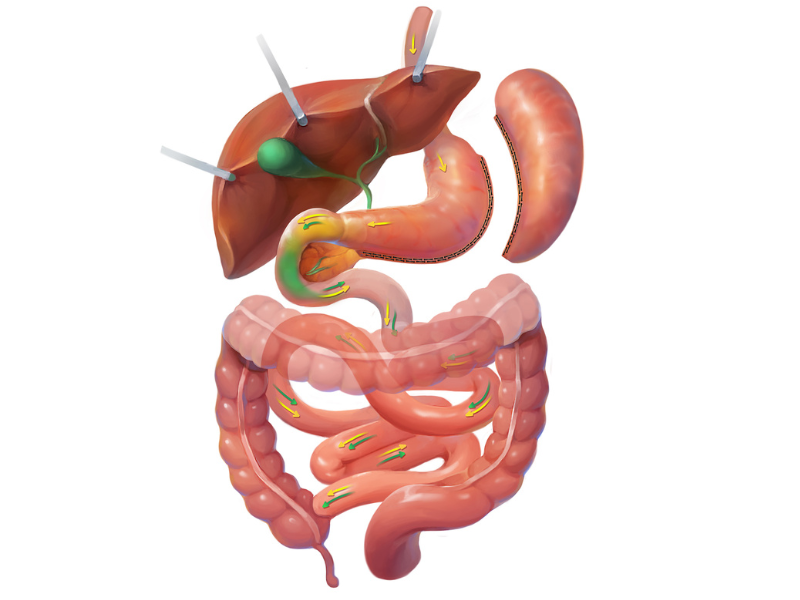The gastric sleeve, also known as sleeve gastrectomy or vertical sleeve gastrectomy, is currently the most popular bariatric surgery procedure in the United States. The sleeve is one of the primary weight loss surgery procedures offered by Dr. Shawn Tsuda in Nevada. Gastric sleeve surgery started as the first part of the two-part duodenal switch. This was especially helpful for extremely obese patients (BMI >60) who needed the sleeve as a way to reduce their BMI before going in for the second, malabsorptive surgical procedure. However, over time, surgeons and patients realized that the gastric sleeve was effective on its own. As a result, the sleeve became a major standalone bariatric procedure.

Gastric Sleeve Surgery
How The Gastric Sleeve Works
Part of the gastric sleeve’s popularity stems from its simplicity. Approximately 75 to 80% of the stomach is separated and removed from the abdomen. The division is made along the greater curvature of the stomach, leaving the remaining stomach about the same size and shape as a banana or a sleeve. Hence the name. The procedure requires approximately one hour of operative time under general anesthesia and can be performed in a hospital or outpatient surgical setting. Almost all of our gastric sleeve surgeries are performed laparoscopically or with robotic assistance. This involves four or five small incisions in the abdomen and a quicker recovery time with fewer potential complications when compared to open surgery, including a decreased risk of developing an incisional hernia.

Results of the Gastric Sleeve
Of course, as with any bariatric procedure, results will vary, often depending on the patient’s willingness and ability to follow their prescribed lifestyle changes. However, most gastric sleeve patients should expect to lose between 60 and 70% of their excess body weight. This is significantly higher than the gastric band, and new long-term data show that it is comparable to the gastric bypass over several years after surgery. Most importantly, many of the diseases associated with obesity, such as type II diabetes, high cholesterol, high blood pressure, sleep apnea, and more, are resolved or improved significantly.
The Benefits of the Gastric Sleeve
As mentioned before, one of the most significant benefits of the gastric sleeve is that it is a relatively simple procedure with fewer risks and lifestyle limitations than a gastric bypass or a duodenal switch. Further, since the gastric sleeve is performed laparoscopically or minimally invasively, the risk of blood loss, pain, and infection is reduced while hospital stay and recovery are significantly shortened.
Some patients will also benefit from reduced hunger due to the fundus of the stomach being removed during surgery. The fundus is a significant source of the hunger hormone ghrelin. When the stomach is divided and removed, it can no longer produce this hormone. Since there are other ghrelin-producing centers in the body, not all patients will experience this benefit, but we estimate that about 50% do.
Gastric sleeve patients will also benefit from a somewhat more liberal dietary regimen than those undergoing gastric bypass or a duodenal switch. This is because the digestive system remains largely intact, including the pyloric valve between the stomach and small intestine. Patients do not experience dumping syndrome as with the gastric bypass, and do not have an implanted medical device as with the gastric band. While most patients will remain on a daily multivitamin for the rest of their lives, their risk of vitamin and mineral deficiencies is much lower compared to a malabsorptive procedure.
Risks of the Gastric Sleeve
As with any major surgical procedure, there are inherent risks of surgery, which can include a reaction to general anesthesia, blood loss, pain, infection, and, in sporadic cases, death. The standardization of the gastric sleeve technique, along with improvements in surgical techniques and equipment, has made the procedure exceptionally safe, comparable to gallbladder removal.
There are also risks associated with any abdominal procedure, which can include injury to nearby organs during surgery, incisional hernias, and more.
Lastly, the risks of the gastric sleeve, in particular, can include, although rare, leaks from the staple line, which require corrective surgery. Long-term patients who do not follow their post-operative diet risk stretching the stomach pouch and regaining weight. In some circumstances, a revisional bariatric surgery may be appropriate. Interestingly, some patients may see their reflux worsen, while others may develop reflux after surgery.
Ultimately, the majority of patients who undergo gastric sleeve surgery are very successful and find that their postoperative diet and exercise plans are not as drastic as they first thought. With long-term data showing that the gastric sleeve is comparable to the gastric bypass in excess body weight loss and disease resolution, there is a very compelling case for this procedure.
Next Steps…
Learn more about Gastric Sleeve Surgery as well as other procedures by joining our seminar.
